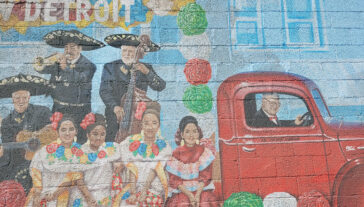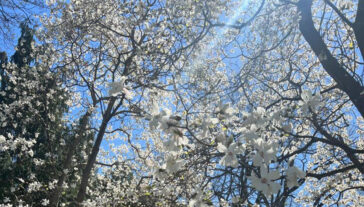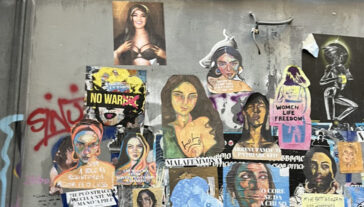Lamp Listeners’ Art Odyssey: Exploring UMMA’s Vibrant Collection

Lamp/ランプ is a Japanese band formed in February 2000, consisting of members Taiyo Someya (guitar), Yusuke Nagai (vocal, accordion, and flute), and Kaori Sakakibara (bass and vocal). With 8 albums and 6 EPs under their belt, their most recent release is “Dusk to Dawn” (2023). Their musical style defies easy categorization, drawing inspiration from diverse sources such as Brazilian bossa nova and Western rock music from the 60s and 70s. However, their music exhibits a clear fusion of genres like Shibuya-kei, bossa nova, jazz, city pop, indie, and J-pop. Nevertheless, it’s the dream-like quality that most aptly characterizes their sound.
Today, I’ll guide you through UMMA artwork that resonates with the ethereal essence of Lamp’s music. But before we embark on this journey, let’s explore how Lamp emerged as a prominent musical force.
Their journey began in 2001 with their debut performance at a quaint bar in Tokyo. Fueled by dreams of landing a record deal that same year, they diligently crafted multiple demo tapes. Fortunately in 2002 when they crossed paths with a representative from the former record label Motel Bleu. Under Motel Bleu, they released their first three albums: “Soyokaze Apartment Room 201,” “For Lovers,” and “At Komorebi St.” However, despite initial success, discontent brewed among the members due to the constraints of creative control imposed by the label. This frustration culminated in the creation of “For Lovers,” which as stated by Someya is infused with an unabashed “us against the world” attitude. Ironically, this album ranks among my top 2 favorites of theirs.
This frustration continued and ultimately led to a decisive break from their label in 2005 after the release of their third album “Komorebi St.” Lamp made a triumphant return in 2008 with “Lamp Genso,” their very first self-produced album and another personal favorite of mine. However, in 2014, the band joined a record label, Polystar, for their seventh album, “Yume.” However, dissatisfaction once again arose, prompting them to decisively depart in 2017 and establish their own label, Botanical House, which remains active to this day.
The somber yet tranquil atmosphere depicted in James Abbott McNeill Whistler’s painting “Sea and Rain” from 1865 resonates with the emotional landscape conveyed in Lamp’s songs “恋人へ /For Lovers,” “冬の影は哀しみ / Sorrow Of Winter,” and “秋の手紙/Autumn letter.” The painting’s blue and grey hues, as well as the misty coastline background, are reminiscent of the album cover for “For Lovers,” which has two band members standing against a backdrop of a frigid, blue-grey shore. This visual connection reveals a shared emotional depth and atmospheric resonance between the artwork and the music. The color combination of the painting and album cover invokes melancholy while also radiating a profound sense of tranquility, reflecting the calming but introspective nature of Lamp’s music. The slow tempo and soothing voices in these songs transport listeners into the breezy, cold atmosphere represented in “Sea and Rain” (1865), adding to the immersive experience of both the painting and the music.
When looking at the misty purple, yellows, and blues in Johann Berthelsen’s painting “Crépuscule,” (1920) — which offers a view towards Central Park South from the park — one cannot help but be drawn into the cozy ambiance of strolling through the city. Although Central Park and its surrounding area are commonly associated with a bustling urban environment, the soft, hazy blending of colors creates a sense of warmth and closeness. Although Central Park and its surrounding area are commonly associated with a bustling urban environment, the soft, hazy blending of colors creates a sense of warmth and closeness. The soft upbeat jazz melodies of Lamp’s songs “ひろがるなみだ/Hirogaru-Namida,” “夕暮れ / Twilight,” and “夕星のペーソ/Dusk” resonant with the atmosphere this artwork creates. Just as the painting captures the serene beauty of Central Park at dusk, Lamp’s music encapsulates the essence of urban life, with its moments of tranquility amidst the city’s vibrant energy. The painting’s cozy hues combined with Lamp’s ambient melodies create a multisensory experience enabling viewers and listeners to immerse themselves in the enchanting setting of the city at dusk.
The songs “紙魚だらけの唄 /Before the Storm” and “部屋の窓辺/From the Window” by Lamp, with their use of instruments like accordion and acoustic guitar, along with Lamp’s soft vocals, evoke a sense of classic 60s French cinema films like “Une femme est une femme.” This musical combination transports listeners to a world of cozy nostalgia, much like the atmosphere depicted in Henri Toulouse-Lautrec’s painting “Ta Bouche” (1893). The soft yellows and browns of the painting, set within a bedroom, create a warm and intimate space, mirroring the cozy atmosphere crafted by the songs.
Other Lamp songs, such as “6号室/Room No. 6,” blend elements of city-pop, jazz, and synth-pop, creating a dream-like lullaby effect. This fusion of genres enhances the music’s nostalgic and immersive quality, akin to the peaceful experience of being lulled into sleep, much like the subject in Toulouse-Lautrec’s painting. Thus, the songs and paintings share a common concept of creating a relaxing and comforting ambiance whether through music or visuals, evoking a sense of nostalgia and calm.
Though my main focus has been on Lamp’s jazzier works and pieces at UMMA that have an energy similar to that of the music, I find that Wojciech Fangor’s 1969 painting resonates more with Lamp’s more funk-inspired songs, like “梨の午後に/Windy Afternoon,” “伊洩陽の季節/Komorebi,” and “今夜の亿節/Us Tonight.” Fangor’s artwork features vibrant colors organized in distorted, squiggly shapes that reflect funk music’s colorful and quirky essence. Fangor’s artwork features bold colors organized in distorted, squiggly shapes that reflect funk music’s colorful and quirky essence. The painting’s vibrant colors, fluid shapes, and sense of movement all work together to generate an atmosphere of energy similar to the infectious rhythms and melodies featured in these Lamp tracks.
Furthermore, the title of Lamp’s song “木洩陽の季節 / Komorebi,” which means “Season of Sunlight Filtering Through Trees,” corresponds to the visual imagery in Fangor’s artwork. The title and song itself depict a dance of light and shadow, which can invoke a mood and imagery similar to the swaying motion evoked by the color and shapes of Fangor’s artwork. Ultimately, the dynamic energy and bold aesthetics shared by Fangor’s painting and Lamp’s funk-inspired music create an intriguing dialogue between visual and auditory expression, demonstrating how different art forms can intersect and complement one another in evoking emotions and sensations.
Enoc Perez’s painting “Lipstick Building” (2015) presents a mesmerizing depiction of modernist architecture with its striking color palette. The vivid gold metallic base contrasts with the layered greens, yellows, pinks, and lavenders, resulting in a striking arrangement. The layering of colors creates a sense of double vision, which adds to the painting’s dreamy aspect. This dreamlike quality is further enhanced by the metallic gold base, which gives the artwork a hint of techno-futurism, implying a fusion of modernity and fantasy.
In parallel, Lamp’s tracks such as, “春ノ空 / Spring Emptiness” and “今夜も君にテレフォンコール / Telephone Call” share a vibrant yet dreamy vibe. These tracks draw influence from the popular 1980s city pop genre, which is known for its vibrant and electric jazz-infused sound. The songs convey nostalgia and urban flare, reflecting the painting’s dynamic energy and vibrant colors. Moreover, the painting’s flashy and vibrant aesthetics are consistent with the bright vocals and distinct jazz sound of city pop music. Just as the painting captures the essence of modernist architecture through its vibrant colors and layered composition, Lamp’s music encapsulates a similar spirit through its fusion of genres and evocative melodies.
The muted colors and subdued lighting in the Japanese gallery set the stage for a serene experience, where this collection of paintings by Manika Nagare Track of Colors #1 (2022-2023) becomes a standout feature. These paintings are based on color schemes from nine works by lesser-known Japanese female artists. Nagare applied each coat of paint meticulously after the preceding layer had fully dried, signifying the layers of history that separated Nagare from the artists who came before her. This collection exudes an overwhelming sense of love for art and the painters who paved the way for today’s creators. Additionally, the paintings’ linear arrangement pays homage to traditional museum techniques of showing works, subtly highlighting how museums have long disregarded the contributions of women and artists of color. Nagare’s artworks pay heartfelt tribute to women and POC artists, demonstrating the importance of their legacies.
Lamp’s songs “日曜日のお別れ/Out on Sunny Sunday,” “愛の言葉/Words of Love,” and “二十歳の恋 / Cherry Blossom Love” convey an essence of tranquility and introspection, much like these paintings. These songs, with their evocative lyrics, mirror the delicate strokes of paint and intense emotions found in Nagare’s paintings. The powerful combination of saxophone and guitar in “Out on Sunny Sunday” produces a dazzling yet serene atmosphere that complements the paintings’ colorful yet muted tones. The combination of light drums and synth beats in “Words of Love” creates an intimate and tender atmosphere, akin to the setting Nagare’s works are placed within. The song “Cherry Blossom Love,” with its Brazilian folk feel and light instrumentals, captures the fleeting beauty of changing seasons and the essence of love, complementing the paintings’ commentary on history in art. The lyrics and artworks through shared themes of love, appreciation, and the passage of time, create a cohesive experience. Both of these mediums work together to encourage listeners and viewers to immerse themselves in a world in which time stands still, allowing for introspection.
I hope this article not only inspires you to come visit the UMMA but also listen to more Lamp!! And if you want the full sensory experience I have detailed listen to this playlist during your next UMMA visit.°˖✧◝(⁰▿⁰)◜✧˖°
Featured Objects in this Blog Post

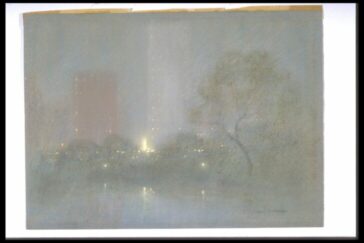
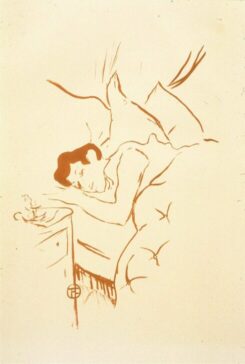
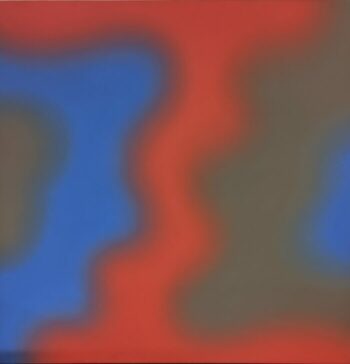
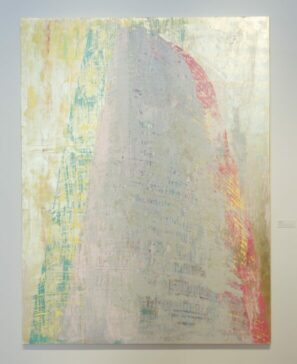
More from UMMA
